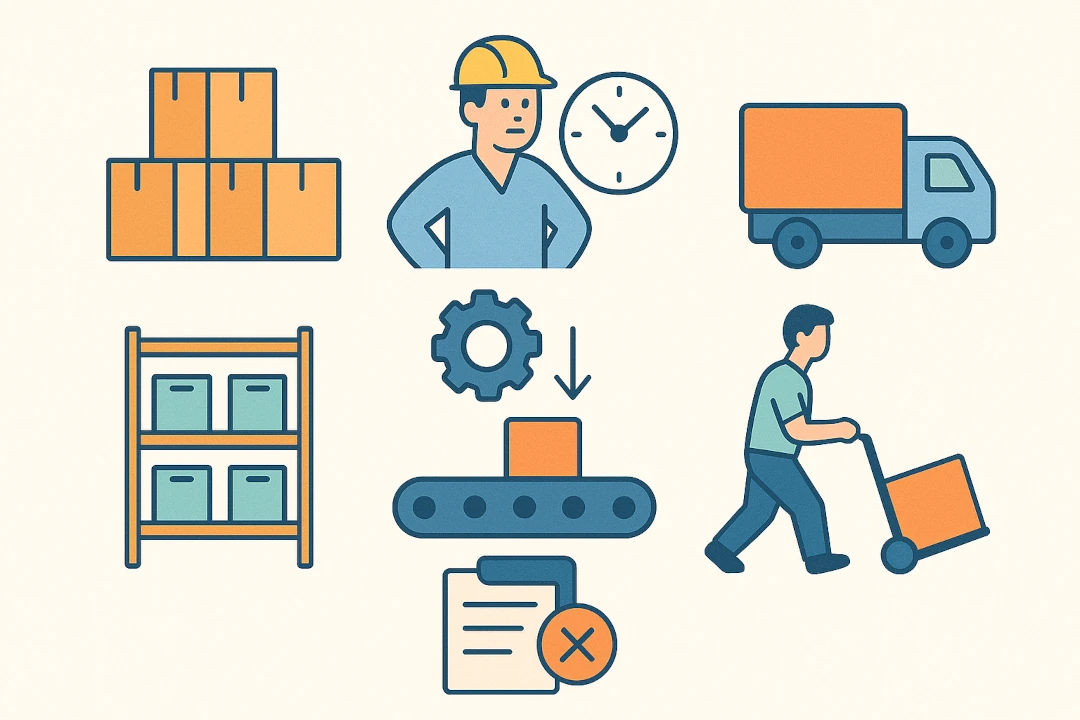Startseite » 7 wastes of lean manufacturing

Image: Sample illustration
In classical lean management according to the teachings of Taiichi Ohno, 7 types of waste are distinguished. Numerous examples of these 7 wastes of lean manufacturing (known as “Muda” in Japanese) can be found in every production environment. Therefore, it should not be misunderstood: a complete elimination of waste is not possible. In fact, they can sometimes cause each other, such as a reduction in inventory triggering waiting times for resupply. At the same time, they can multiply: overproduction increases inventory, and consequently, the transportation effort.
Knowledge of the 7 wastes of lean manufacturing is intended to help identify process weaknesses and efficiency losses more easily and reduce them more effectively.
A quick overview over the 7 wastes of lean manufacturing:
A useful mnemonic for remembering the 7 wastes of lean manufacturing is the acronym TIM WOOD (Transport, Inventory, Movement, Waiting, Over-Production, Over-Engineering, Defects).
All seven types of waste share the characteristic of being non-value-adding processes in production. Strictly speaking, only the primary utilization time of the operational resources is value-adding. Therefore, in a project, the activities that are non-value-adding and thus represent waste must be identified.
The scope of the project should include the assessment of waste. For example, the transport of components to hardening furnaces in another hall is a non-value-adding activity. However, if considered at the operational level, such as within the framework of a continual improvement process (CIP), the rough layout of the production is assumed to be fixed, and the transport is mandatory. To reflect this situation, the category of value-enabling processes can be introduced, as transport enables the value creation brought by the hardening furnaces. On a strategic level, this would still be critically examined as a non-value-adding activity.
In addition to the above-mentioned “basic types of waste“, further types of waste are distinguished depending on the literature. These include:
Transport is not a value-adding activity. However, it is very prevalent and is an integral part of manufacturing processes within companies, often referred to as intralogistics. Transport encompasses any movement, whether of (raw) materials, semi-finished and finished products, tools, or equipment.
Due to process-related, physical, and structural conditions, transport is often unavoidable and thus frequently falls into the category of necessary value-enabling waste. Nonetheless, the goal should be to reduce transport as much as possible and to keep walking and transport distances as short as possible.
High inventories can conceal other issues in production. For example, a lack of process harmonization can be masked by high safety stocks.
Waiting refers to the time when a worker is not adding value, such as waiting for the completion of a production process or for material replenishment.
Similarly, material can also “wait,” meaning idle times during which a product is not undergoing value-adding processes, leading to increased lead time.
Waiting times directly contribute to an increase in lead time. At the same time, they reduce employee productivity. As a result, longer lead times can lead to order delays and economic damage.
Overproduction occurs when more is produced than what is currently demanded by customers. In the case of make-to-stock production, this is common and leads to inventories. As previously discussed regarding inventories, this can also be a competitive advantage. However, overproduction always creates a need for storage space and incurs storage costs. In the production of perishable goods, the impacts are particularly critical, necessitating optimization to minimize overproduction as much as possible. Additionally, the future demand for produced quantities is not guaranteed, and the revenue that can be achieved is uncertain.
The effects can vary from immediate negative impacts to hindering additional positive influences. Depending on the individual case, additional costs, time loss, higher scrap rates, or lower margins may occur.
You need to load content from reCAPTCHA to submit the form. Please note that doing so will share data with third-party providers.
More InformationYou are currently viewing a placeholder content from Facebook. To access the actual content, click the button below. Please note that doing so will share data with third-party providers.
More InformationYou are currently viewing a placeholder content from Google Maps. To access the actual content, click the button below. Please note that doing so will share data with third-party providers.
More Information